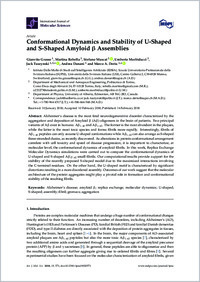Conformational dynamics and stability of U-shaped and S-shaped amyloid β assemblies
- Grasso, Gianvito Istituto Dalle Molle di studi sull'intelligenza artificiale (IDSIA), Facoltà di scienze informatiche, Università della Svizzera italiana, Svizzera
- Rebella, Martina Department of Mechanical and Aerospace Engineering, Politecnico di Torino, Corso Duca degli Abruzzi 24, IT-10128 Torino, Italy
- Muscat, Stefano Department of Mechanical and Aerospace Engineering, Politecnico di Torino, Corso Duca degli Abruzzi 24, IT-10128 Torino, Italy
- Morbiducci, Umberto Department of Mechanical and Aerospace Engineering, Politecnico di Torino, Corso Duca degli Abruzzi 24, IT-10128 Torino, Italy
- Tuszynski, Jack Department of Mechanical and Aerospace Engineering, Politecnico di Torino, Corso Duca degli Abruzzi 24, IT-10128 Torino, Italy - Department of Physics, University of Alberta, Edmonton, AB T6G 2R3, Canada
- Danani, Andrea Istituto Dalle Molle di studi sull'intelligenza artificiale (IDSIA), Facoltà di scienze informatiche, Università della Svizzera italiana, Svizzera
- Deriu, Marco A. Istituto Dalle Molle di studi sull'intelligenza artificiale (IDSIA), Facoltà di scienze informatiche, Università della Svizzera italiana, Svizzera
-
14.02.2018
Published in:
- International journal of molecular sciences. - 2018, vol. 19, no. 2, p. 571
Alzheimer’s disease
Amyloid β
Replica exchangeb
Molecular dynamics
U-shaped
S-shaped
Assembly
Fibril
Gromacs
Aggregation
English
Alzheimer’s disease is the most fatal neurodegenerative disorder characterized by the aggregation and deposition of Amyloid β (Aβ) oligomers in the brain of patients. Two principal variants of Aβ exist in humans: Aβ1–40 and Aβ1–42. The former is the most abundant in the plaques, while the latter is the most toxic species and forms fibrils more rapidly. Interestingly, fibrils of Aβ1–40 peptides can only assume U-shaped conformations while Aβ1–42 can also arrange as S-shaped three-stranded chains, as recently discovered. As alterations in protein conformational arrangement correlate with cell toxicity and speed of disease progression, it is important to characterize, at molecular level, the conformational dynamics of amyloid fibrils. In this work, Replica Exchange Molecular Dynamics simulations were carried out to compare the conformational dynamics of U-shaped and S-shaped Aβ17–42 small fibrils. Our computational results provide support for the stability of the recently proposed S-shaped model due to the maximized interactions involving the C-terminal residues. On the other hand, the U-shaped motif is characterized by significant distortions resulting in a more disordered assembly. Outcomes of our work suggest that the molecular architecture of the protein aggregates might play a pivotal role in formation and conformational stability of the resulting fibrils.
- Language
-
- English
- Classification
- Chemistry
- License
- Open access status
- gold
- Identifiers
-
- RERO DOC 328285
- DOI 10.3390/ijms19020571
- ARK ark:/12658/srd1319165
- Persistent URL
- https://n2t.net/ark:/12658/srd1319165
Statistics
Document views: 180
File downloads:
- Texte intégral: 193
